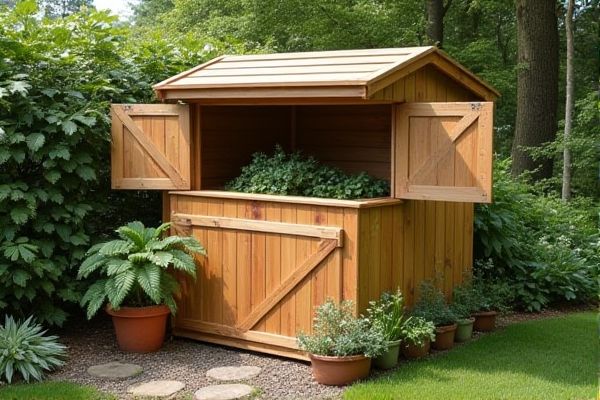
Wooden compost bins offer natural insulation and breathability, promoting efficient decomposition, while plastic compost bins are lightweight, durable, and often more resistant to weather conditions. Discover which compost bin suits Your gardening needs best by reading the full comparison in the article.
Table of Comparison
| Feature | Wooden Compost Bin | Plastic Compost Bin |
|---|---|---|
| Material | Natural wood (cedar, pine, etc.) | Durable plastic (polyethylene, polypropylene) |
| Durability | Moderate; prone to rot and weather damage | High; resistant to weather, pests, and decay |
| Breathability | Excellent; natural air circulation | Limited; requires vents for airflow |
| Insulation | Good; retains heat to speed composting | Moderate; can retain heat but less natural |
| Environmental Impact | Eco-friendly; biodegradable | Non-biodegradable; recyclable |
| Maintenance | Higher; may need sealing or repairs | Low; easy to clean and maintain |
| Cost | Usually higher initial cost | Generally more affordable |
| Weight | Heavier | Lightweight |
| Assembly | May require tools and time | Often pre-assembled or easy snap-fit |
Introduction: Wooden vs Plastic Compost Bins
Wooden compost bins offer natural insulation and breathable materials that promote aerobic decomposition, while plastic compost bins provide durability and weather resistance with less maintenance. Your choice depends on factors like climate, budget, and desired composting speed, since wooden bins may require more upkeep but enhance microbial activity. Both options effectively recycle organic waste, but wooden bins align better with eco-friendly aesthetics and plastic bins excel in longevity and pest resistance.
Material Overview: Wood and Plastic Explained
Wooden compost bins, typically made from cedar, pine, or redwood, offer natural insulation, breathability, and biodegradability, promoting aerobic decomposition and moisture regulation. Plastic compost bins, constructed from high-density polyethylene (HDPE) or recycled plastics, provide durability, resistance to weathering, and often feature airtight designs to retain heat but can limit airflow. The choice between wood and plastic depends on factors like environmental impact, maintenance requirements, and composting efficiency.
Durability and Longevity Comparison
Wooden compost bins offer natural breathability and can last several years with proper treatment but are prone to rot and insect damage, especially in damp conditions. Plastic compost bins are highly durable, resistant to weather and pests, and often last longer without maintenance due to their waterproof nature. Choosing between the two depends on your priority for natural materials versus long-term resilience and minimal upkeep.
Environmental Impact and Sustainability
Wooden compost bins offer greater environmental sustainability due to their biodegradability and use of renewable materials, reducing plastic waste and chemical pollution. Plastic compost bins, while durable and lightweight, often involve fossil fuel consumption and contribute to microplastic contamination if degraded improperly. You can enhance your eco-friendly gardening by choosing wooden bins that support mindful resource use and minimize environmental harm.
Insulation and Composting Efficiency
Wooden compost bins offer superior insulation due to their natural ability to retain heat, which accelerates the decomposition process and maintains consistent microbial activity. Plastic compost bins often lack insulation properties, causing slower composting during colder months as heat dissipates quickly. Choosing a wooden bin can enhance your composting efficiency by creating a stable environment for organic material breakdown year-round.
Maintenance and Upkeep Requirements
Wooden compost bins require regular treatment to prevent rot, insect damage, and weathering, often needing periodic sealing or staining to maintain durability. Plastic compost bins offer low maintenance, as they resist moisture, pests, and decay, making them easier to clean and largely weatherproof. Your composting routine may benefit from choosing plastic bins if you prefer minimal upkeep, while wooden bins provide a natural aesthetic but demand more consistent care.
Cost Analysis: Initial and Long-Term Expenses
Wooden compost bins typically have a higher initial cost due to quality timber materials and craftsmanship but offer greater durability and natural insulation, potentially reducing maintenance expenses over time. Plastic compost bins are generally more affordable upfront, with lower purchase prices and lightweight design, though they may degrade faster under UV exposure, leading to replacement costs. Your choice should consider how these initial and long-term expenses align with your budget and composting goals.
Aesthetics and Garden Integration
Wooden compost bins blend seamlessly with natural garden landscapes, providing a rustic and organic aesthetic that enhances overall outdoor beauty. Plastic compost bins offer a more modern, uniform appearance and are available in various colors to match garden decor, but may lack the natural charm of wood. Your choice depends on whether you prioritize natural integration or versatility in design.
Pest and Odor Control Considerations
Wooden compost bins naturally provide better aeration, helping to reduce odors and deter pests by allowing moisture to escape more efficiently. Plastic compost bins, while more airtight and resistant to weather, may trap moisture and odors, potentially attracting pests if not managed properly. Your choice should consider local pest activity and how effectively you can maintain proper airflow and moisture levels to minimize odors and unwanted critters.
Conclusion: Which Compost Bin is Right for You?
Wooden compost bins offer excellent durability and natural aeration, making them ideal for gardeners seeking eco-friendly and breathable composting solutions. Plastic compost bins provide lightweight, moisture-retentive, and pest-resistant benefits, suitable for urban or small-space composting with minimal maintenance. Choosing between wooden and plastic compost bins depends on your climate, space, budget, and preference for sustainable materials or convenience.
 homyna.com
homyna.com